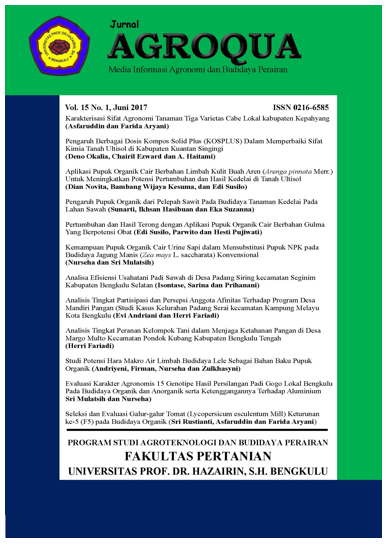AKLIMATISASI PLANLET TEBU (Saccharum officinarum L.) DARI BENIH SINTETIK PADA BEBERAPA MEDIA DAN KONSENTRASI NUTRISI
DOI:
https://doi.org/10.32663/ja.v21i1.3279Keywords:
AB mix, rockwool, husk charcoal, perlite, plantletAbstract
Sugarcane (Saccharum officinarum L.) synthetic seeds are somatic embryos encapsulated with sodium alginate into a seed-like shape. The purpose of this study was to determine the right combination of planting media and nutrient concentrations for acclimatization of sugar cane plantlets from synthetic seeds. This research was conducted in April 2019-January 2020 at the Center of Development of Advance Science and Technology (CDAST) University of Jember. The research design was carried out using factorial RAL with 2 factors and repeated 3 times. The first factor was the treatment of husk charcoal, perlite and rockwool planting media, while the second factor was the treatment of AB mix nutrient concentrations of 500 ppm, 750 ppm, 1000 ppm and 1250 ppm and using analysis of variance (ANOVA) if the results obtained were significantly different, an analysis was carried out proceed with the Duncan's Multiple Range Test (DMRT) at the 95% level of confidence. Parameters observed during acclimatization were root length, plant height and number of leaves. The results of plantlet acclimatization from synthetic seeds showed that the best medium was rockwool with a seedling height of 21.9 cm, number of leaves 8 leaves, root length 13.6 cm. The best nutrient concentration was AB mix 500 ppm with a plant height of 20.5 cm, number of leaves 7.5 and root length 9.6 cm.
References
Downloads
Published
Issue
Section
License
Authors who publish with this journal agree to the following terms:
- Authors grant the journal right of first publication with the work simultaneously licensed under a Creative Commons Attribution 4.0 Internasional (CC BY 4.0) Licence that allows others to use and share the work with an acknowledgment of the work's authorship and initial publication in this journal.
- The author(s) still hold the copyright of his/her/their work and retain publishing rights without restrictions such as (but not limited to) patent right, lecture, book and reproduce the article for own purposes.
















